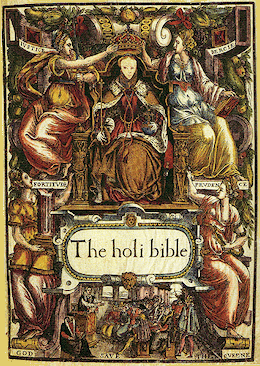Textus Receptus Bibles
Bishops Bible 1568
| 17:1 | And there came one of the seue angels, which had the seuen vials, & talked with me, saying vnto me: Come, I wyll shewe vnto thee the iudgement of the great whore that sitteth vpon many waters: |
| 17:2 | With whom haue committed fornication the kynges of the earth, and the inhabiters of the earth are dronken with the wyne of her fornication. |
| 17:3 | So he caryed me away in the spirite into the wildernesse: And I sawe a woman sit vpon a scarlet coloured beast, ful of names of blasphemie, which had seuen heades, and ten hornes. |
| 17:4 | And the woman was arayed in purple and scarlet colour, and decked with golde, precious stone, and pearles, and had a cup of golde in her hande, full of abhominations and fylthynesse of her fornication. |
| 17:5 | And in her forehead was a name written, a misterie, great Babylon, the mother of whoredome & abhominations of the earth. |
| 17:6 | And I sawe ye woman dronken with the blood of the martirs of Iesus: And when I sawe her, I wondred with great maruayle. |
| 17:7 | And the angell sayde vnto me: wherfore maruaylest thou? I wyll shewe thee the misterie of the woman, and of the beast that beareth her, which hath seuen heades, and ten hornes. |
| 17:8 | The beast that thou seest, was, and is not, and shall ascende out of the bottomlesse pyt, and shall go into perdition, and they that dwell on the earth shall wonder (whose names are not written in the booke of lyfe from the begynnyng of the world) when they beholde the beast that was, and is not, and yet is. |
| 17:9 | And here is a mynde that hath wisdome. The seuen heades, are seuen mountaynes on whiche the woman sitteth: They are also seuen kynges. |
| 17:10 | Fyue are fallen, & one is, and another is not yet come: And whe he commeth, he must continue a short space. |
| 17:11 | And the beast that was, and is not, is euen the eyght, and is one of the seuen, and shall go into destruction. |
| 17:12 | And the ten hornes which thou sawest, are ten kynges, which haue receaued no kyngdome as yet: but shall receaue power as kynges at one houre with the beast. |
| 17:13 | These haue one mynde, and shal geue their power & strength vnto the beast. |
| 17:14 | These shall fyght with the lambe, and the lambe shall ouercome them: For he is Lorde of Lordes, and Kyng of Kynges, and they that are on his syde, are called, and chosen, and faythfull. |
| 17:15 | And he sayde vnto me: The waters which thou sawest, where the whore sitteth, are people, and folke, & nations, and tongues. |
| 17:16 | And the ten hornes which thou sawest vpon the beast, are they that shall hate the whore, and shall make her desolate and naked, and shall eate her fleshe, and burne her with fire. |
| 17:17 | For God hath put in their heartes to fulfyll his wyll, and to do with one consent, for to geue their kyngdome vnto the beast, vntyll the wordes of God be fulfylled. |
| 17:18 | And the woman which thou sawest, is that great citie which raigneth ouer the kynges of the earth. |

Bishops Bible 1568
The Bishops' Bible was produced under the authority of the established Church of England in 1568. It was substantially revised in 1572, and the 1602 edition was prescribed as the base text for the King James Bible completed in 1611. The thorough Calvinism of the Geneva Bible offended the Church of England, to which almost all of its bishops subscribed. They associated Calvinism with Presbyterianism, which sought to replace government of the church by bishops with government by lay elders. However, they were aware that the Great Bible of 1539 , which was the only version then legally authorized for use in Anglican worship, was severely deficient, in that much of the Old Testament and Apocrypha was translated from the Latin Vulgate, rather than from the original Hebrew, Aramaic and Greek. In an attempt to replace the objectionable Geneva translation, they circulated one of their own, which became known as the Bishops' Bible.